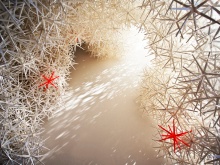Informed Matter - Aggregate Structure
Block Seminar for 1:1 Prototype Construction
NEW INTRODUCTION DATE: 24.04.2013 - 09.30-11.00 Room 10.23, ICD
The one-week block seminar ‘Informed Matter - Aggregate Structure’ aims at developing and realizing a full-scale architectural prototype from a synthetically produced granulate.
Aggregates are defined as large amounts of unbound elements lying in loose frictional contact. In nature they are known from systems like sand or snow. In the building industry they are mostly used as an additive in concrete construction, yet are rarely explored in their unbound form.
As opposed to their relative novelty within an architectural design context, loose granulates bear several characteristics which are specifically suited for building design applications – especially if the individual granulate is custom-designed. On the one hand these synthetic aggregate structures are fully re-configurable as they can reversibly move from liquid to solid states. On the other hand they can be functionally graded within one and the same material system, through admixing of variable-property granules during the pouring process.
Especially relevant is the development of novel design methods as the loose granulates cannot be controlled using conventional design- and fabrication methods. They rather need to be observed using both material and machine computational techniques such that an interaction rather than an actual planning process occurs between the granular material system and the designing architect.
During the block seminar students will work with an already fabricated synthetic granulate consisting of 50000 particles which are filling ca. 12 cubic metres. The goal is to produce a spatial shell or configuration that is in pure compression, which uses the available material as economically as possible. The numerical simulation of the aggregate by means of specific software will initially be used for the development of possible spatial configurations. These will consequently be tested through physically pouring the granulate over a pneumatic formwork. Physical experiment and numerical simulation will increasingly be embedded in a feed-back loop over the course of the design and construction process. The spatial configurations will be documented and evaluated using photographic and video-techniques. The seminar is open for students who enjoy working on large-scale physical models. Previous experience with animation- and simulation software is advantageous yet not a pre-condition for participating.
Selected Projects
Block Seminar for 1:1 Prototype Construction
NEW INTRODUCTION DATE: 24.04.2013 - 09.30-11.00 Room 10.23, ICD
The one-week block seminar ‘Informed Matter - Aggregate Structure’ aims at developing and realizing a full-scale architectural prototype from a synthetically produced granulate.
Aggregates are defined as large amounts of unbound elements lying in loose frictional contact. In nature they are known from systems like sand or snow. In the building industry they are mostly used as an additive in concrete construction, yet are rarely explored in their unbound form.
As opposed to their relative novelty within an architectural design context, loose granulates bear several characteristics which are specifically suited for building design applications – especially if the individual granulate is custom-designed. On the one hand these synthetic aggregate structures are fully re-configurable as they can reversibly move from liquid to solid states. On the other hand they can be functionally graded within one and the same material system, through admixing of variable-property granules during the pouring process.
Especially relevant is the development of novel design methods as the loose granulates cannot be controlled using conventional design- and fabrication methods. They rather need to be observed using both material and machine computational techniques such that an interaction rather than an actual planning process occurs between the granular material system and the designing architect.
During the block seminar students will work with an already fabricated synthetic granulate consisting of 50000 particles which are filling ca. 12 cubic metres. The goal is to produce a spatial shell or configuration that is in pure compression, which uses the available material as economically as possible. The numerical simulation of the aggregate by means of specific software will initially be used for the development of possible spatial configurations. These will consequently be tested through physically pouring the granulate over a pneumatic formwork. Physical experiment and numerical simulation will increasingly be embedded in a feed-back loop over the course of the design and construction process. The spatial configurations will be documented and evaluated using photographic and video-techniques. The seminar is open for students who enjoy working on large-scale physical models. Previous experience with animation- and simulation software is advantageous yet not a pre-condition for participating.
Selected Projects


